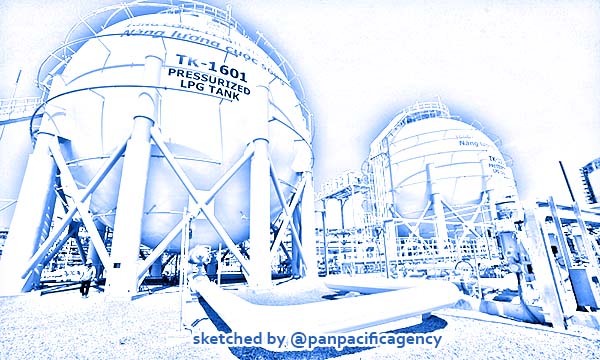Malaysia ranks among China’s top gasoline importers in June

Pressure vessels containing liquefied gas are seen at a plant of PetroVietnam Gas. Photo courtesy of PetroVietnam Gas. Sketched by the Pan Pacific Agency.
KUALA LUMPUR, Jul 21, 2021, S&P Global. China’s gasoline exports to Malaysia recovered to 204,200 mt in June from just 8,500 mt in May, making it the second biggest recipient of Chinese outflows in the month, showed detailed data released July 21 by the General Administration of Customs, S&P Global reported.
The June gasoline exports were largely steady compared with the average volume of around 192,700 mt shipped to Malaysia in the past 10 months of July 2020-April 2021, the data showed.
During the first half of 2021, total gasoline exports to Malaysia were at 1.12 million mt, up 74.9% on the year. Further, China imported about 36,000 mt of gasoline from Malaysia via companies registered in Hainan province, in addition to 24,700 mt from Singapore, the data showed.
CNOOC imported 50,000 mt of gasoline resulting in a profit of Yuan 15 million/mt ($5.46 million/b). Of the 50,000 mt imported, the first 25,000 mt was injected into oil tanks in Nantong in east China. Trading company Sinochem also imported several cargoes to benefit from good margins in the domestic market, S&P Global Platts reported earlier.
In addition, China exported rare cargoes totaling 50,000 mt to Saudi Arabia in June, after such shipments were last made in September 2019 at 56,000 mt. The latest exports came at a time when Saudi Arabia’s 400,000 b/d Jazan refinery has become fully operational, largely reducing its dependence on imported gasoline barrels for the next six months.
In H1, Southeast Asia remained the top destination for China’s gasoline outflows, with the region accounting for about 90% of the total. Australia has also increased its imports from China by 160.8% on the year at 213,000 mt.
Australia props China’s gasoil exports
China exported 2.36 million mt of gasoil in June, up 40.4% from just 1.68 million mt in the previous month.
The incremental volumes mainly went to Australia, which received 441,000 mt of the fuel in June, up 182.8% month on month.
The steep jump in June volumes also made Australia China’s third-largest gasoil recipient in H1. Australia’s imports from China in H1 stood at 1.84 million mt, rising 103.6% compared with the same period a year earlier.
The higher gasoil imports by Australia were largely supported by robust demand in the mining sector amid decreasing domestic supplies due to refinery closures.
BP and ExxonMobil announced closures of their Kwinana and Altona refineries, respectively, leaving Australia with only two operating refineries — Viva Energy’s 128,000 b/d Geelong and 109,000 b/d Lytton refineries — and increasing the country’s reliance on refined products imports.
Australia’s Department of Industry, Science, Energy and Resources forecast the country’s total refined products imports to rise to 806,000 b/d in 2021-22 and 825,000 b/d in 2022-23 from 655,000 b/d in fiscal 2020-21 (July-June).
Hong Kong also increased its gasoil procurement from the mainland to 223,000 mt in June, up 93.8% on the month.
In addition, the Netherlands and Tanzania, which seldom import gasoil from China, each imported cargoes of 83,000 mt and 62,000 mt, respectively, in June.
H1 quotas drying up
China exported 13 million mt of gasoil in H1, up 14.6% year on year, while gasoline exports were 21.3% higher at 9.57 million mt over the same period. However, jet fuel exports were still 52.1% lower year on year at 3.7 million mt.
This left only 3.2 million mt of quotas available for export from July onward, which will likely prompt China to cut gasoline, gasoil and jet fuel exports to just 1.15 million mt, a six-year low, Platts reported earlier.
Market participants told Platts they were expecting Beijing to release the second batch of export quotas for the rest of the year, at about 9.5 million mt, by end-July.